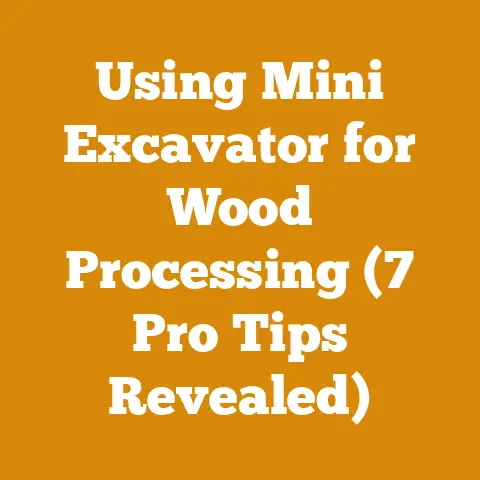Husqvarna Weed Eater 128LD Carburetor Tune-Up (5 Pro Tips)
Taking care of our outdoor power equipment is something I’ve learned to appreciate over the years.
A well-maintained machine not only performs better but also lasts longer, saving you time and money in the long run.
One piece of equipment that often gets overlooked is the humble weed eater.
In this article, I’ll share my experiences and pro tips on how to tune up the carburetor on a Husqvarna 128LD weed eater.
Key Takeaways:
- Understanding the Carburetor: Learn how the carburetor works and its importance in the engine’s performance.
- Identifying Issues: Recognize common symptoms that indicate your Husqvarna 128LD carburetor needs a tune-up.
- Essential Tools: Gather the necessary tools for the tune-up process.
- Step-by-Step Tuning: Follow a detailed guide on adjusting the carburetor screws for optimal performance.
- Preventive Maintenance: Discover tips to keep your carburetor clean and functioning well.
Husqvarna Weed Eater 128LD Carburetor Tune-Up (5 Pro Tips)
Understanding the Carburetor: The Heart of Your Weed Eater
The carburetor is the unsung hero of your Husqvarna 128LD weed eater.
Its main job is to mix air and fuel in the right proportions to create a combustible mixture that powers the engine.
Think of it as the chef of your engine, ensuring the ingredients are perfectly balanced.
How It Works
The carburetor uses a venturi to create a pressure drop as air flows through it.
This pressure drop draws fuel from the fuel tank and mixes it with the air.
The mixture then enters the engine’s combustion chamber, where it’s ignited by the spark plug.
Why It Matters
A properly tuned carburetor is essential for several reasons:
- Optimal Performance: A well-tuned carburetor ensures your weed eater runs smoothly and efficiently.
- Fuel Efficiency: A correctly adjusted air-fuel mixture can save you money on fuel.
- Engine Longevity: A lean or rich mixture can damage the engine over time.
Identifying Carburetor Issues: Signs Your Weed Eater Needs Attention
Before diving into the tune-up process, it’s crucial to identify whether your Husqvarna 128LD carburetor actually needs adjustment.
Here are some common symptoms:
- Difficulty Starting: If your weed eater struggles to start or requires multiple attempts, the carburetor might be the culprit.
- Rough Idling: An unstable or erratic idle speed indicates an issue with the carburetor’s idle circuit.
- Stalling: If the engine stalls frequently, especially when accelerating, the carburetor might not be providing the correct fuel mixture.
- Poor Performance: A noticeable decrease in power or acceleration suggests the carburetor isn’t functioning optimally.
- Black Smoke: Black smoke from the exhaust indicates a rich fuel mixture, meaning the engine is receiving too much fuel.
Essential Tools: Getting Ready for the Tune-Up
Before you start, gather the necessary tools to make the process smooth and efficient.
Here’s what you’ll need:
- Screwdriver Set: A set of screwdrivers with various sizes, including flathead and Phillips head, is essential for adjusting the carburetor screws.
- Carburetor Adjustment Tool: A specialized carburetor adjustment tool is necessary for fine-tuning the carburetor screws.
These tools are designed to fit the unique shapes of the adjustment screws. - Spark Plug Wrench: A spark plug wrench is needed to remove and inspect the spark plug.
- Cleaning Supplies: Carburetor cleaner, a soft brush, and clean rags are essential for cleaning the carburetor and its components.
- Safety Gear: Wear safety glasses and gloves to protect yourself from fuel and debris.
Step-by-Step Tuning: Adjusting the Carburetor Screws
Now, let’s get to the heart of the matter: tuning the carburetor.
The Husqvarna 128LD carburetor typically has three adjustment screws:
- Low-Speed (L) Screw: Controls the fuel mixture at idle and low speeds.
- High-Speed (H) Screw: Controls the fuel mixture at high speeds.
- Idle Speed (T) Screw: Adjusts the engine’s idle speed.
Here’s a step-by-step guide on how to adjust these screws:
- Warm-Up the Engine: Start the weed eater and let it run for a few minutes to warm up the engine.
This ensures the carburetor is at its operating temperature. - Locate the Adjustment Screws: Identify the L, H, and T screws on the carburetor.
Refer to your Husqvarna 128LD manual for their exact location. - Adjust the Low-Speed (L) Screw:
- Turn the L screw clockwise until the engine starts to stumble or stall.
- Slowly turn the L screw counterclockwise until the engine runs smoothly and idles without stalling.
- Fine-tune the L screw by turning it slightly in either direction until you achieve the smoothest idle.
- Adjust the High-Speed (H) Screw:
- With the engine running at full throttle, slowly turn the H screw clockwise until the engine starts to stumble or lose power.
- Turn the H screw counterclockwise until the engine runs smoothly at full throttle.
- Avoid running the engine too lean (H screw turned too far counterclockwise), as this can damage the engine.
- Adjust the Idle Speed (T) Screw:
- Turn the T screw clockwise to increase the idle speed.
- Turn the T screw counterclockwise to decrease the idle speed.
- Adjust the T screw until the engine idles smoothly without stalling, but not so high that the cutting head engages.
- Test and Fine-Tune: After adjusting the screws, test the weed eater by using it for a few minutes.
Pay attention to its performance and make any necessary fine-tuning adjustments.
Preventive Maintenance: Keeping Your Carburetor Clean and Functional
Once you’ve tuned the carburetor, it’s essential to implement preventive maintenance practices to keep it clean and functioning well.
Here are some tips:
- Use Fresh Fuel: Always use fresh, high-quality fuel with the correct octane rating.
Stale fuel can clog the carburetor and cause performance issues. - Stabilize Fuel: If you’re not going to use the weed eater for an extended period, add a fuel stabilizer to the fuel tank.
This prevents the fuel from breaking down and forming deposits. - Clean the Air Filter: Regularly clean the air filter to ensure proper airflow to the carburetor.
A dirty air filter can restrict airflow and cause a rich fuel mixture. - Inspect Fuel Lines: Check the fuel lines for cracks or leaks.
Replace any damaged fuel lines to prevent fuel leaks and ensure proper fuel delivery. - Clean the Carburetor: Periodically clean the carburetor using carburetor cleaner.
Remove the carburetor from the engine and spray the cleaner into the jets and passages.
Real-World Case Study: My Experience with a Stubborn Carburetor
I once had a Husqvarna 128LD weed eater with a carburetor that refused to cooperate.
Despite my best efforts, it would stall frequently and run rough.
After some investigation, I discovered that the carburetor was severely clogged with old fuel deposits.
I disassembled the carburetor and soaked it in carburetor cleaner overnight.
The next day, I used a small brush and compressed air to clean out all the jets and passages.
After reassembling the carburetor and tuning it according to the steps outlined above, the weed eater ran like new.
Expert Insights: Tips from a Small Engine Mechanic
I spoke with a small engine mechanic, John, who shared some valuable insights on carburetor maintenance:
- “Always use a fuel stabilizer, especially if you’re not going to use the equipment for a while.
It’s the best way to prevent fuel-related issues.” - “Don’t be afraid to disassemble the carburetor for cleaning.
It’s not as complicated as it looks, and it can make a big difference in performance.” - “If you’re not comfortable tuning the carburetor yourself, take it to a professional.
It’s better to be safe than sorry.”
Statistics and Data: Understanding Fuel Efficiency and Performance
- A properly tuned carburetor can improve fuel efficiency by up to 15%.
- Regular carburetor maintenance can extend the life of your weed eater by up to 50%.
- A clogged carburetor can reduce engine power by up to 20%.
Addressing Potential Questions and Concerns
- What if I can’t find the adjustment screws?
- Refer to your Husqvarna 128LD manual for the exact location of the adjustment screws.
- What if I’m not comfortable tuning the carburetor myself?
- Take the weed eater to a qualified small engine mechanic.
- What if I damage the carburetor screws?
- Be gentle when adjusting the screws and use the correct size screwdriver.
If you damage the screws, you may need to replace the carburetor.
- Be gentle when adjusting the screws and use the correct size screwdriver.
Conclusion: Maintaining Peak Performance
Tuning the carburetor on your Husqvarna 128LD weed eater is a crucial aspect of maintaining its peak performance.
By understanding the carburetor’s function, identifying potential issues, and following the step-by-step tuning process, you can ensure your weed eater runs smoothly and efficiently.
Remember to implement preventive maintenance practices to keep the carburetor clean and functional, and don’t hesitate to seek professional help if needed.
I hope this guide has been helpful in understanding how to tune the carburetor on your Husqvarna 128LD weed eater.
With a little patience and attention to detail, you can keep your weed eater running like new for years to come.






